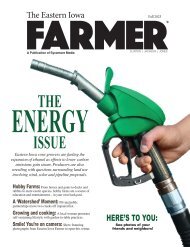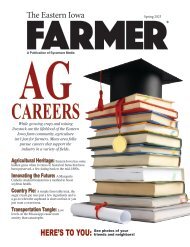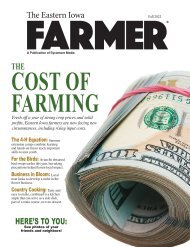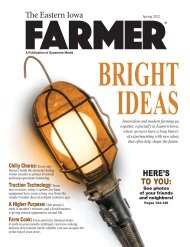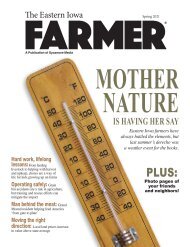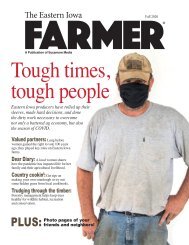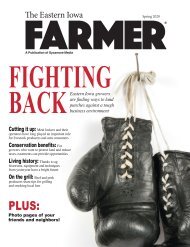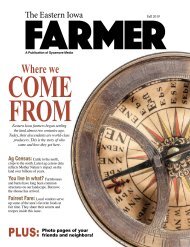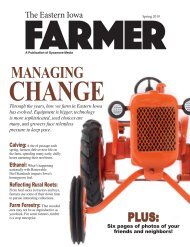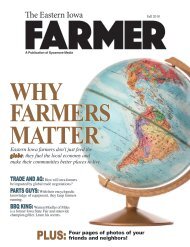You also want an ePaper? Increase the reach of your titles
YUMPU automatically turns print PDFs into web optimized ePapers that Google loves.
PASTURE CARE<br />
Pasture improvement<br />
has its rewards<br />
Eastern Iowa cattlemen can add grazing capacity<br />
without always expanding acres<br />
BY LOWELL CARLSON<br />
EASTERN IOWA FARMER<br />
There is something about an<br />
expanse of grassland. Spring<br />
pastures with that deep green<br />
color that comes with the first<br />
new growth of the grazing season. Here<br />
in Eastern Iowa, livestock producers face<br />
the pressure of row crop production and<br />
dwindling pasture acreage. The result<br />
is even more pressure on the grazing acreage<br />
a farm can support.<br />
As idyllic as the above description of<br />
pasture might be, it has been a challenge<br />
in recent years as regional drought conditions<br />
stress pastures.<br />
Eastern Iowa pasture acres are silently<br />
disappearing, converted to row crops. In<br />
1945 Iowa had nearly 7 million acres of<br />
permanent pasture. A recent ag census<br />
indicated that category had dwindled to<br />
2.1 million acres. Once converted from<br />
livestock to crop acres, pasture seldom<br />
returns in the scheme of land use.<br />
Jackson County is far and away the<br />
Eastern Iowa region with the largest stock<br />
cow numbers, around 90,000 head. If<br />
Iowa were a range state, say Wyoming, it<br />
would be called ranch country with these<br />
cattle numbers.<br />
Part art, part science, pasture management<br />
is a mostly untapped part of<br />
many farm enterprises. From turnout in<br />
the spring through the hot, dry heat of<br />
late summer, pastures are under constant<br />
stress – from fickle weather, insects, and<br />
weeds, not to mention wear and tear from<br />
stock concentration and compaction.<br />
Because most livestock have the<br />
potential to obtain a large portion of their<br />
feed from grazing, pastures and field crop<br />
residue need to be more than an open area<br />
of underperforming biomass of doubtful<br />
quality.<br />
Rotational grazing, moving livestock<br />
through a series of fenced paddocks, was<br />
made popular by livestock producers in<br />
Europe and especially in New Zealand.<br />
It can produce more forage per acre than<br />
conventional open pasture grazing.<br />
Farmers may be able to stock at a higher<br />
rate once established and make better<br />
use of available forage. It’s adjusting<br />
FOR ALL YOUR REAL ESTATE NEEDS<br />
➤ FARMS ➤ RESIDENTIAL ➤ ACREAGES ➤ COMMERCIAL<br />
• Live and Online Auctions<br />
• Farmland Purchases and Sales<br />
• Estimates of Value<br />
Chuck<br />
Schwager,<br />
Broker<br />
LINDA<br />
BAILEY<br />
AMY<br />
DAEHLER<br />
Our experienced agents can guide you<br />
through the selling or buying process keeping<br />
it as stress free as possible.<br />
“We are people just like you!”<br />
Chuck: 563-599-4277<br />
125 S. 2ND ST., MAQUOKETA, IA | (563) 652-0000<br />
eastiowaland.com<br />
amy.daehler@yahoo.com<br />
563-349-5899<br />
108 EASTERN IOWA FARMER | SPRING 2024 eifarmer.com





